Did you resolve to be a stronger nonprofit supporter this year, but not sure where to start? Already a nonprofit supporter, but want to be more strategic in your giving decisions? Make the most of your charitable donations this year by following these easy-to-use tips and tricks.
1. Create a “Giving” budget. It’s always helpful to have a plan for how you want to give throughout the year. Take a moment to think about how much you can and want to donate. Also consider when during the year you are able to give. Maybe it’s once a month, maybe it’s twice a year; no two giving budgets are the same.
2. Consider your values. Not sure how you would rate your values? Try printing these value cards and categorizing them as 1) Very important to me, 2) Important to me, and 3) Not important to me. Now try narrowing down the “very important to me” values to your top three. Once you’ve identified your top 3 values, let those guide and inform your giving decisions.
3. Be Proactive. Now that you’ve identified your values, consider causes or topics that are of interest to you. Seek out organizations that are doing work that you care about and ask a few questions before choosing to support their efforts. Our Fall edition of the Smart Giver Newsletter provides you with a tool to use when reaching out to nonprofits for the first time. Check it out here!
4. It’s okay to say “No.” It can be hard to turn away a friend, family member, or even the stranger whose emotional appeal could win an Oscar. Saying “no” isn’t always easy, and it’s made even more difficult when you don’t have a clear reason for why. Now that you’ve identified your top 3 values, use those to guide your giving decisions, saying “no” when opportunities don’t align.
5. It’s okay to say “Yes!” Perhaps you’re more of an impulsive giver? You give by participating in an impromptu charity walk with a friend, or buying cookie dough from your niece/nephew. That’s okay too! If you find that you’re more of an impulsive giver, don’t sweat it. You can still plan accordingly. Create a budget just for impulsive giving. Perhaps you set aside $100 for impulsive giving this year, alongside your $100 of planned giving to your favorite nonprofit. Find what works for you and your giving habits.
6. Take advantage of your employer’s matching gift program. The easiest way to make your gift go further, is to have your employer match your gift. Contact your employer to find out if this is an option for you.
7. Keep a record of your contributions. To ensure that you are able to take advantage of the charitable giving tax benefits, you’ll want to track the organizations you are giving to, their address, and the amount you gave. If your gift is over $250, you will also need a receipt from the organization for tax filing purposes.
8. Donate your stuff. In addition to donating your money, you can also consider donating your gently used clothing, furniture, and household items. However, many nonprofits have limits on what they can accept. So do your research, before planning to make a drop-off this spring. For more information check out our blog on the topic.
9. Get involved. Giving doesn’t always equate to money. Many nonprofits benefit from individuals giving of their time and talents. Not only is volunteering a way to give back, but it’s also a great way to build a relationship with organizations you might be considering supporting financially.
10. Be a smart giver. Last but certainly not least, don’t forget to be a smart giver! Use our list of strong and trustworthy nonprofits to make your giving decisions. The nonprofits on our list have met our 25 Accountability Standards®, which focus on strong governance policies, fundraising practices, financial health and public disclosure. All very important for nonprofit strength.


